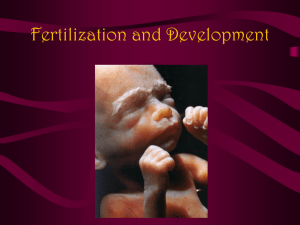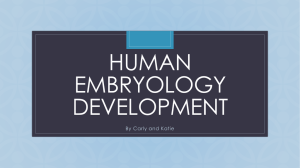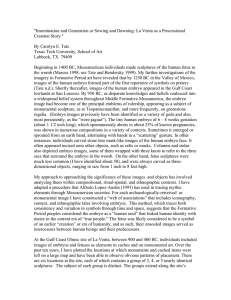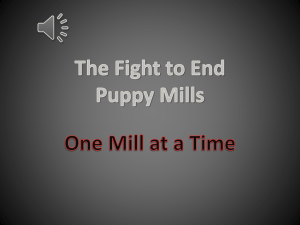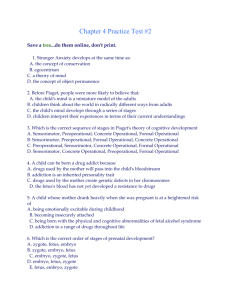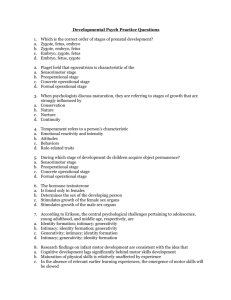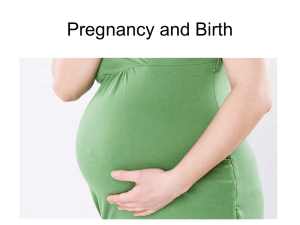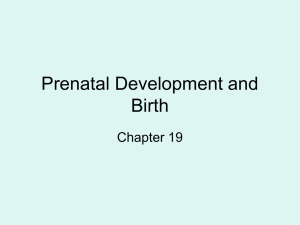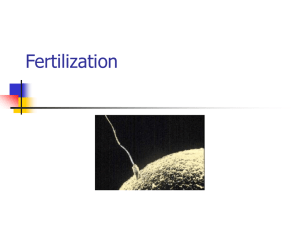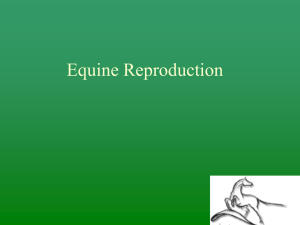The Path to Puppies
advertisement
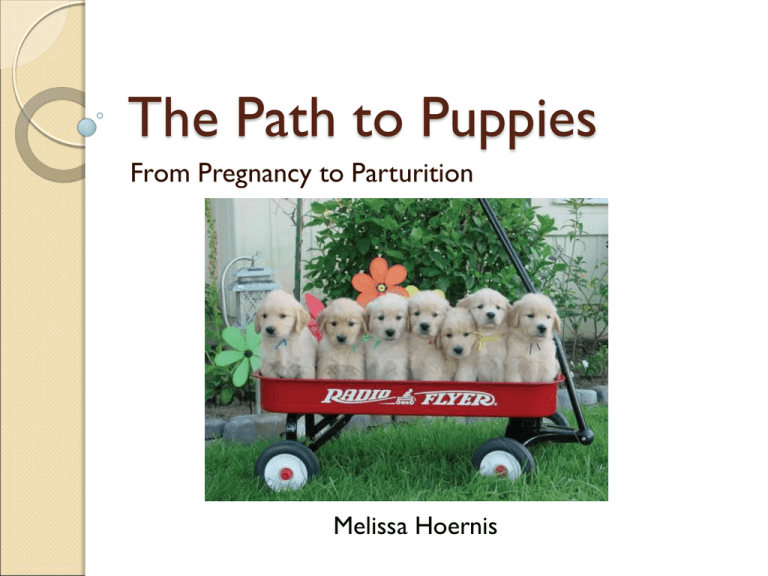
The Path to Puppies From Pregnancy to Parturition Melissa Hoernis Terms Pregnancy: The state of carrying developing embryos or fetuses in the female body Parturition: The process of giving birth to offspring Female Reproductive Tract of Dogs Ovary: Place where the ova is made and released from Suspensory ligament Ovary Oviduct: Connects the ovary to the uterus Uterus: Oviduct Place that holds the growing fetuses Cervix: Acts as a barrier to keep bacteria from getting to the growing fetuses Pelvic canal: The birth canal (the way the fetuses get to the outside world) Uterine horn Uterine body Cervix Pelvic Canal Conception: formation of an embryo ◦ An embryo is formed when the egg becomes fertilized and starts growing from one single cell into thousands then millions. What about the GENES! Genes hold the information to build and maintain an organism's cells and pass traits to offspring DNA This is what is in the nucleus of a cell and is the blueprints for the entire body Chromosome Gene DNA Number of Chromosomes Each cell in a dog has 39 PAIRS of chromosomes for a total of 78! 39 pairs = 78 total Each gamete (egg/ sperm) has HALF the genetic information needed 39 chromosomes from the mother 39 chromosomes from the father 78 chromosomes total So when they combine the genetic information is made complete! A quick course in EMBRYOLOGY The egg is fertilized and then starts dividing and multiplying EXPONENTIALLY Then this clump of cells starts to change and form different types of tissues that then form organs then organ systems. This is called differentiation. Cell- smallest unit Tissue- groups of cells with same general function and texture (example: Muscle) Organ- two or more types of tissues that combine to serve a specific function (example: Stomach) Organ system- several organs that work together to serve a specific function (example: Digestive system) Development of the embryo What is an embryo? An embryo is what we call the puppy from the point when the egg is fertilized until the body is fully developed (just miniature). Growth of the fetus What is a fetus? Once the embryo is fully developed it still needs time to grow while it is in the mother’s womb. The fetus is what we call the puppy once it is fully developed but still growing. Guess the species of each embryo! How about now? OKAY… How about now? Fish Salamander Tortoise Chicken Pig Cow Rabbit Human The Placenta The Placenta is a temporary organ formed in the uterine wall of the mother that is connected to the fetus via the umbilical cord. The Placenta Purpose: ◦ Nutrients The fetus needs food to grow ◦ Gas exchange The fetus cannot breath but it’s body still needs oxygen to work so the mother provides oxygen ◦ Waste elimination Gestation Length The length of time from conception until birth Let’s COMPARE 63 Days 335 Days 63 Days 270 Days 625 Days Pregnancy What are some signs that the female is pregnant? (can you guess any) ◦ Weight gain (doesn’t start until week 4) ◦ Increased appetite (again not until week 4 and some have decreased appetite at times) ◦ Nesting behavior ◦ Drop in temperature Tools veterinarians use to diagnose pregnancy Radiographs ◦ Fetal skeletons seen by day 42 ◦ Best way to find out how many there are Ultrasound ◦ Beating hearts by day 25 Measurement of certain hormones Parturition- the birthing process There is a hormone cascade and feedback system! It all starts with FETAL STRESS! Positive feedback loop: The hypothalamus (a part of the brain) sends a signal by way of the hormone oxytocin to the uterus causing contractions. The pressure of the fetus on the cervix sends a signal back to the brain which then stimulates the release of more oxytocin. Uterus Mother’s brain Complications What happens if the mother cannot give birth (puppies are too big, mother is too tired) ◦ The veterinarian must perform a c-section Nursing It is extremely important for newborn puppies to drink milk from their mother Not only does it provide a source of food that is easy to digest but it also gives the newborns immunity! (basically they are protected from certain diseases) Key things to monitor in a newborn puppy Weight gain: you want to know they are EATING (1 gram per pound of adult weight per day) Temperature: puppies can become cold very easily and cannot shiver until 6 days old (keep environment at 86°F) Mother has to help them urinate and defecate Look for body defects (cleft palate) Fun facts and owner education Open eyes from days 10-15 Open ears from days 15-17 Wean puppies at 3-4 weeks Socialization period is 4-12 weeks of age Let’s put it all together! Day 78 Day 84 Day 1 Day 63 Day 73 Day 91 Gestation length Conception Embryo Fetus Body fully developed Wean Birth Eyes open Ears open Start Socialization In Summary… The puppy is conceived and gets half the genetic information from the mother and half from the father The embryo develops into a fetus that grows in the womb. During the birthing process there are many hormones that are part a positive feedback loop that ultimately cause contractions. Newborn puppies must be monitored closely to ensure they are eating, gaining weight and maintaining a proper body temperature.

